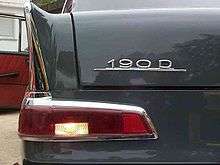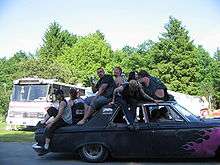Raggare



Raggare (Norwegian: Råner) is a subculture found mostly in Sweden and parts of Norway,[1][2] Finland,[3] Denmark, Germany, Austria and Russia. Raggare are related to the greaser subculture and are known for their love of hot rod cars and 1950s American pop culture.
While the raggare movement has its roots in late 1950s youth counterculture, today it is associated mainly with middle aged men who enjoy meeting and showing off their retro American cars. However, the subculture retains its rural and small town roots as well as its blue collar and low brow feel. The original phenomenon unleashed moral panic but the contemporary raggare subculture tends to be met with amusement or mild disapproval by mainstream society.
Description
Influences
The Raggare subculture's influences are American popular culture of the 1950s, such as the movies Rebel Without a Cause with James Dean, and American Graffiti.[2]
Cars
Cars are an important part of the subculture, especially V8-powered cars and other large cars from the USA.[4] Statistically, the most common raggare car (Swe raggarbil) is the 1960s Pontiac Bonneville. They are plentiful, classic, relatively cheap, and have a huge backseat so the Raggare can pile in all of their friends. Raggare have been described as closely related to the hot rod culture, but while hotrodders in the US have to do extensive modifications to their cars to stand out, raggare can use stock US cars and still standout compared to the more sober Swedish cars.[4] Some raggare also drive European cars from the 50's, 60's and the 70's.
Due to Raggare culture there are more restored 1950s American cars in Sweden than in the entire USA[5] and although only two 1958 Cadillac convertibles were sold in Sweden there are now 200 of them in Sweden.[5] Between 4000 and 5000 classic US cars are imported to Sweden each year.[5]
Fashion
The clothes and hairstyle are that of 1950s rockabilly. Blue jeans, cowboy boots, white T-shirts, sometimes with print (also used to store a pack of cigarettes by folding the sleeve), leather[6] or denim jacket. The hair is styled using Brylcreem or some other pomade.
Symbols
The confederate flag seem to be popular items in the subculture as they embrace the rebellious message of the flag.[7]
History
Formation of the raggare culture was aided by Sweden staying neutral during World War II and untouched by the war, due to which, Sweden's infrastructure remained intact, the country was receiving aid from the Marshall Plan, and export economy boomed, which made it possible for the working-class Swedish youth to buy cars, in contrast to most of the rest of the Europe, which needed to be rebuilt.[8]
When raggare first appeared in the 1950s, they caused a moral panic with concerns about the use of alcohol, violence, high-speed driving, and having sex in the back seat. Raggare gangs were seen as a serious problem.[9] The film Raggare! covered the issue in 1959.
Later, raggare often got into fights with hippies and punks,[10][11][12][13][14] something described in the punk rock song "Raggare Is a Bunch of Motherfuckers" by Rude Kids[15] (and later re-recorded by Turbonegro). When The Sex Pistols played in Sweden on 28 July 1977, a group of raggare waited outside and cornered some young girls who came out from the show. The girls had safety pins through their cheeks, and the raggare ripped them right out of their faces. The band was upstairs drinking beer when they heard about it. Sid Vicious wanted to go down and fight, and someone else suggested they should get the limousine and run them over. In the end, the gig promoter called the police. The Hjo band Reklamation was forced to cancel a gig after threats from raggare.[16] Also, Rude Kids was forced to cancel a sold out gig as the police didn't have the manpower to offer protection against raggare. When Rude Kids played in Stockholm the police had to bring in seven police cars to stop the raggare.[17] When The Stranglers played in Sweden, their followers were caught making Molotov cocktails, and the police intervened after a fight broke out.[18]
In 1996 the Swedish post office issued a stamp featuring raggare.[19]
Public image

Because of their mostly rural roots, retro-aesthetics, and low-brow attitude towards sex, raggare are often depicted as low-educated and with not too much money. The most famous modern example being the TV characters "Ronny and Ragge", a pair of idiots who cruise around in a beat-up Ford Taunus. There are several gatherings for raggare around Sweden. The Power Big Meet is the most famous, and is also one of the biggest American car meets in the world.
In the media and other popular culture
- In 1975, then glam rocker Magnus Uggla made the song "Raggarna", which was a tribute to the culture. Ironically, when performing live in late 1970s and early 1980s, raggare threw rocks and tried to thrash the arenas in which Uggla performed, accusing him of being a punk rocker due to his success with the more punk-oriented albums he released in the late 1970s.
- Eddie Meduza have performed songs like "punkjävlar" ("punk bastards"), or "Ragga Runt," a tribute to the Raggare subculture.
- Rude Kids made a song about raggare (later re-recorded by Turbonegro) called "Raggare Is a Bunch of Motherfuckers", as an answer to "punkjävlar" by Eddie Meduza. The large number of punk songs about raggare shows the conflict between the two subcultures.
- The 1959 film Raggare! was about raggare and the moral panic of the time.
- The TV series Ronny & Ragge is about two raggare who cruise around in a beat-up 1976 - 1994 Ford Taunus.
- Onkel Kånkel made a song about raggare behaviour during cruising called "Åka femtitalsbil" (later covered by Charta 77).
- The early Swedish punk band P.F. Commando has issued a song called "Raggare" on their 1978 Svenne Pop 7" EP, see .
- Raggargänget (1962) with Ernst-Hugo Järegård and Sigge Fürst
- Massproduktion published a compilation album titled "Vägra Raggarna Bensin – Punk Från Provinserna".
- On 1 May 1979 about 100 punks formed their own parade down Kungsgatan under the slogan "Vägra raggarna bensin" (Refuse the raggare gasoline).[20]
- Nadja's brothers "Roffe", "Ragge" and Reinhold, Bert
- Tjenare Kungen(2005)
- In Welcome to Sweden, Bengt is a raggare, and delighted to meet his niece's American boyfriend because of it.
See also
- Harry
- White trash
- Rednecks
- Deep South
- Neo-Confederate
- Greaser (subculture)
- Kustom Kulture
- Rockabilly
- Mods and Rockers
- Rockers
- Teddy Boy
- Transatlantic relations, relating to the assimilation of American and Canadian cultures into a pan-European soil.
- Atlanticism
- Special Relationship
References
- ↑ The Police Journal, v.38 1965, page 58
- 1 2 OA: Råning og ragging på utstilling
- ↑ 'http://www.stadin-raggarit.com/history.htm
- 1 2 Automobilities by Mike Featherstone, Nigel. Thrift, John Urry. p. 189
- 1 2 3 Today: Sweden's car kings: 'greasers' cruising in vintage US wheels
- ↑ Crime and Its Correction: An International Survey of Attitudes and Practices by John Phillips Conrad, p.126
- ↑ Jalopnik: Your Guide To Europe's Weirdest Car Culture: Raggare
- ↑ https://www.vice.com/read/raggare-love-hot-rods-and-rock-n-roll-000926-v20n2
- ↑ Statistics on Delinquents and Delinquency by Walter Albin Lunden, p.134
- ↑ Arbetaren: Raggaren lever än
- ↑ England's dreaming: les Sex Pistols et le punk by Jon Savage, Denys Ridrimont, p.435
- ↑ Aftonbladet: Raggare rövade bort punkare
- ↑ Dala Demokraten: Förföljelserna mot oss hårdnar
- ↑ Vermlands Folkblad: Vi törs inte gå ut på kvällarna
- ↑ The Guardian: Raggare: the Swedish rock'n'roll cult comes of age
- ↑ SLA: Unga musiker i Hjo hotade med stryk, 3 mars 1979
- ↑ Aftonbladet: Raggare stoppar punkband
- ↑ GT: Tvingades fly från raggarna
- ↑ Consumption: Critical Concepts in the Social Sciences by Daniel Miller, p.155
- ↑ Vecko Revyn, Nr 30, 25 July 1979
External links
| Wikimedia Commons has media related to Raggare. |
- Raggare at DMOZ
- Cultural Imperialism or Hyper-Americanization – Swedish raggare and Chicano Lowriders – article by Scott Holmquist
- Raggare video guide
- Raggare – The Movie
- Photos from Power Big Meet by Frank Aschberg
- Stadin Raggarit – Finnish Raggare site Over 6000 pictures and many articles (in Finnish), etc.
- Punktjafs: Raggare – music and period articles about punks and raggare